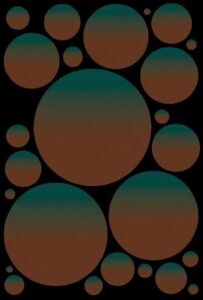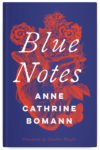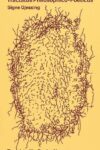
[Lolli Editions; 2021]
Tr. from the Danish by Sherilyn Nicolette Hellberg
I always look forward to opening a package from Lolli Editions. The press, based in London but self-described as “European,” publishes slender, shimmering novels in translation. Each time I receive a review copy I’m introduced to a new author and oftentimes an entirely new literary culture. The press is named after Antonio Lolli, an 18th-century composer who lived between Scandinavia, England, Russia, and Italy. His vision went beyond specific schools and he strove to create art without formal or theoretical constraints. Lolli Editions seems to carry on with that aesthetic vision, publishing English translations of gentle, difficult-to-classify literary voices from Europe and across the world. Now, that’s not to say Lolli’s authors remain unheard of on the margins: their authors publish fiction in The New Yorker, and The Employees by Olga Ravn recently made the shortlist for the 2021 International Booker Prize.
Lolli’s books tend to surprise me in a good way. But when I tore open a package a few weeks ago to find Ida Marie Hede’s Adorable, my heart sank. After a long decade of ambiguity and grief regarding motherhood, I didn’t feel like reading something cute or cuddly. I was, or so I thought, beyond babies, in want of art and wild imagination. According to the back-cover blurb Adorable is “a haunting, transmundane portrait of a young family. The love between B and Q is tender but worn. When their daughter Æ is born, the everyday lights up in a new way.”
Oh dear, I thought and put Adorable away for a while. A week later I endeavored to take myself out of the picture and just read the book without reading any more blurbs. The opening pages of Adorable allowed me space to breathe, to simply enjoy the text. That’s what Lolli Editions’ books do best — they blow up all your expectations and anxieties and bring you into that divine place: the deep green word forest.
Adorable begins with all the budding curiosity and primal pleasures of a kindergarten classroom. We are introduced to a delightful, geometric family of three:
B is a grown woman, she has a rhombus-shaped bum.
Q is a grown man, he has a square bum.
Æ is small.
Her bum is heart-shaped.
Compared to ants, beetle and flower pistils, Æ is a giant.
From the perspective of a human—from a B perspective, a Q perspective—Æ is absolutely miniature.
In this opening section, “A Heart-Shaped Bum,” Hede’s prose soars. Each sentence is a fragment of feeling and of life in the most urgent, ethereal sense that I almost didn’t want to turn the page, afraid that such fun would end. Here it was, all that joy of an artist exploring.
Ida Marie Hede is a Danish writer and artist. She’s the author of eight books and numerous plays, although Adorable is the first of her books to be published in English. Hede’s artistic practice is concerned not only with language but also with the visual arts, sound, and art history. That interest in creative practice across art forms is clear in Adorable. This miniature book, just 146 pages, with lots of white space, line breaks, and fragmentary song, explores life cycles through all the senses, sniffing around, in and out of orifices in search of both meaning and pure play.
Hede — in ways that sometimes recall Maggie Nelson, other times my all-time favorite writer on the bodily experience of early motherhood, Anne Enright, and in other moments Eileen Myles’ phenomenal Afterglow, A Dog Memoir — explores ambivalences towards motherhood and revels in the strangeness of caring and cradling. She asks what it physically feels and looks like, even what it sounds and smells like, to grieve, to age, to reproduce, to die. Her interest in the materiality of all of this comes into play in all four sections of the book. The reality of bodily fluids is so incisive that what first seems shocking (a lot of shit, a baby slurping mucus, blood, sperm, and the often-forgotten vaginal discharge are all over this book) becomes part of the narrative arc, the language of a strange other world. Is the setting of the book B’s belly or her brain? Only a fool would separate the two in Hede’s prose.
Through acute observation of bodily experience, Hede asks and often answers fundamental questions. The range of her ambition may not be clear by the size of the book and the playful prose, but she’s meditating on the kinds of questions that rattle around in heads late at night and in the earliest hours of morning. Like, why have children as the world is burning? Hede tells us exactly why, “Now that Æ exists, B wants to survive the apocalypse everyone is talking about. She wants to grow old and wrinkled and shrunken so she can stay in the world with Æ. She wants to communicate with an adult Æ on the phones of the future.”
And don’t we all want to do just this? Turn towards joy in the face of disaster? It seems a bit smug, but it’s also very fun. Hede’s prose is plucky, light. So often the physical aftermath of birth is presented as horrendous, but Hede’s interpretation is altogether wondrous:
B’s belly is flat now. She really loves its doughy flatness. The punctured white softness that will never be tight again.
Before the flatness her belly is temporarily full, absolutely bulging. A piece of skin around something kicking and living, which is Æ.
Æ comes out coated in bacteria from B’s vagina and arse. Bacteria seep into Æ and trigger an immune response: now Æ can live a thousand years.
B bleeds into her big mum-nappy, long slimy strands.
B is back home. She watches movies on the couch while she nurses Æ. In Pasolini’s Salò, a group of teenagers are held captive in a castle. They’re served swollen chunks of shit on porcelain plates, revolted, punctuated by fits of vomiting, down goes the shit.
Æ gurgles, milk spouts out of her and soaks a cloth nappy, a shirt, baby eyelashes, peach fuzz.
Maggie Nelson, in her groundbreaking memoir The Argonauts, saysthat in order to let the baby out, one must risk letting go of the shit, “falling forever, going to pieces.” Hede’s book seems to whisper another sort of perhaps equally sound advice: watch the disintegration very carefully. Observe. If you look closer it might all hurt less.
B’s experience of birth and the immediate aftermath though hopeful is enmeshed with decay:
B tries to approach the idea of inevitable disintegration. That she is decay wrapped in skin, like a moist cake wrapped in fondant.
On the outside:
Crème de la mer, irritated hair follicles, sweat smell, Nivea smell, crusted self-tanner, crusted sugar, crusted discharge, cotton undershirt, wool tights, tweed skirt . . .
Hede’s lists, and there are many of them, are marvelous. Her descriptions and careful observations of the domestic reminded me of sections of Sylvia Plath’s journals, and also of the work of visual artist Kiki Smith. Plath is two generations older than Hede, who was born in 1980, and a generation behind Smith. Like these predecessors, Hede creates an entire universe out of the fluids and cave-like surroundings of women’s bellies:
B kisses Æ goodnight. It’s growling, Æ says, and points at B’s fat rolls: the sound of the belly that in a way still belongs to them both. A space for memories of countless episodes.
To Æ, that belly is like an old house: or like a photograph of a childhood home you can point to and tell stories about. In that room, I was conceived, in that room; I was born.
Æ says:
Mum
in your belly, I saw you pick your nose
in your belly, I ate sausages for the first time
in your belly, I lived in London
in your belly, I learned that whales eat Onkel Reje
Two generations on, for a poet, for an artist, for a novelist, setting a story — so much action — in a woman’s belly still feels quite radical. So, I gave Adorable a chance, because it’s not a meditation on children as liberation, even though reproduction, it seems in this first section, can liberate a person from so many old anxieties:
The anxiety bound to the process of decay has instead become an avid interest in the coquettish signs of change.
But.
When it comes to Æ, the slightest transformation comes with a sense of relief.
Something has come full circle.
The second section of the book, “A Room in B’s Brain is Arranged for the Dead,” consists of just two pages, a short passage that warns the reader of a new cycle:
Here the dead are animate.
The animated dead don’t have any absence, any grief, inside. They have no awareness of themselves as non-living.
They don’t have any regrets.
Then, rather quickly, we get to section three, “Death Essay,” where the narrative voice changes and I began to feel a twinge of regret myself. Despite having thought I wasn’t in the mood for lyrical prose about baby’s bums, I’d enjoyed the beginning of Adorable. The fragments are beautiful, porous, and often quite humorous. In “Death Essay,” our third person omniscient narrator (whom I’d imagined as an insect tinier even than baby Æ) has disappeared and been replaced with an I:
My brother calls and says our father is dead. It’s not an unimaginable death (our dad: his legs almost didn’t work, his brain was contracting), and it’s not the first time I’ve experienced someone dying. It’s a death that brings a sense of relief with it, a death to be expected, but still I know now that you can’t imagine a death, ever.
This section, told in the first person, zooms out from the hyper-focused gaze/haze of early motherhood to the detriment of Hede’s experiment in form and tone. Here she drifts between cultural artifacts (some highbrow theory and others more poppy) along with snapshots of the geopolitical. The playfulness turns clever and therefore the tenderness of the first part no longer feels as radical. Still, despite a reference to children killed by drones, which feels cynical and out of place in this context, and some goofy jokiness that didn’t convince me (“I sit on the sofa and listen to the film’s voices. There’s almost no light in the living room. The voice comes towards me. My stomach rumbles. My intestines are singing Eternal Flame, they want to go out and play”), Hede is able to weave in and out of time, references, and register in ways that are sometimes luminous:
My father dies on a Tuesday. I go to Aarhus on the Wednesday. On Thursday night there’s a seminar on Marguerite Duras in an artistic workshop at Carlsberg in Copenhagen. I don’t cancel, I say I’ll attend by phone. I don’t attend as a body, only as a voice.
In the days after his death, I pick up the phone once: When Marguerite Duras calls.
I’m thirty-two, I’m lying in my mother’s bedroom with the spiral cords of the rotary phone around my wrist, a heavy bracelet, the way a bishop’s robes and crown jewels and armatures with all their complexity give the wearer a sense of solidity.
In the final section, “Friday Night,” we return to the make-believe world of that family of three, Æ, Q, and B, but now their wombworld is punctured, occupied by preoccupations from the outside: people lying in mass graves in Mexico, refugees without identity papers, a girl dressed in pink leggings floating face-down in the soupy Mediterranean.
It’s the confines of patriarchy that so often create the horrors of the darkest tales about motherhood, but Hede tells a more universal, perhaps more ancient horror story in which any house, home, family affair is a grafting, a layering of time. A graveyard and a womb at once. “Sometimes the dead stand with their living family members, still like a mannequin with open eyes, the living look all stiff in the eyes too.” The ending of this superb, little heart-shaped bum of a book is surprising and gorgeous and horrifying all at once. This is an experiment in explaining what it means to inhabit a body, a mother’s body, a baby’s body in this world and in other worlds. Despite the sadness of the last section and the sobriety of its intentions, the message that I came away with was one of hope, an urging, a plea — that if we observe them closely enough, with attention and compassion, both art and biology will give us lifetimes of joy, ways to live and die many times over.
Madeline Beach Carey is the author of the story collection Les filles dels altres. Her work has appeared, or is forthcoming, in El Món d’Ahir, de/rail, RIC Journal, The Sultan’s Seal, The Momentist, Southword, and elsewhere. Carey has been the recipient of award and fellowships from the Bread Loaf Writers’ Conference, the Edward Albee Foundation, Faber Residency, Hawthornden Castle, Greywood Arts, and Ventspils House. She teaches at the Irish Writers Centre and privately.
This post may contain affiliate links.







